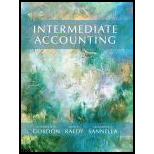
Intermediate Accounting
1st Edition
ISBN: 9780132162302
Author: Elizabeth A. Gordon, Jana S. Raedy, Alexander J. Sannella
Publisher: PEARSON
expand_more
expand_more
format_list_bulleted
Question
Chapter 16, Problem 1BCC
To determine
To explain: The four reasons why the board decided to allow the fair value option.
Expert Solution & Answer
Want to see the full answer?
Check out a sample textbook solution
Students have asked these similar questions
Joe transferred land worth $200,000, with a tax basis of $40,000, to JH Corporation, an existing entity, for 100 shares of its stock. JH Corporation has two other shareholders, Ethan and Young, each of whom holds 100 shares. With respect to the transfer:a. Joe has no recognized gain. b. JH Corporation has a basis of $160,000 in the land.c. Joe has a basis of $200,000 in his 100 shares in JH Corporation. d. Joe has a basis of $40,000 in his 100 shares in JH Corporation. e. None of the above.
I need help with this general accounting problem using proper accounting guidelines.
I am looking for the correct answer to this general accounting problem using valid accounting standards.
Chapter 16 Solutions
Intermediate Accounting
Ch. 16 - Prob. 16.1QCh. 16 - Is reporting an investment at its cost considered...Ch. 16 - Prob. 16.3QCh. 16 - Prob. 16.4QCh. 16 - Prob. 16.5QCh. 16 - Prob. 16.6QCh. 16 - What categories can managers use to classify...Ch. 16 - When is the equity method of accounting for...Ch. 16 - Prob. 16.9QCh. 16 - Can companies apply the fair value option to all...
Ch. 16 - What is the fair value hierarchy for investment...Ch. 16 - Prob. 16.12QCh. 16 - Prob. 16.13QCh. 16 - Prob. 16.14QCh. 16 - Prob. 16.15QCh. 16 - Prob. 16.16QCh. 16 - Prob. 16.17QCh. 16 - Deutsch Imports has three securities in its...Ch. 16 - Prob. 16.2MCCh. 16 - Prob. 16.3MCCh. 16 - Prob. 16.4MCCh. 16 - Prob. 16.5MCCh. 16 - Prob. 16.6MCCh. 16 - Prob. 16.7MCCh. 16 - Prob. 16.1BECh. 16 - Prob. 16.2BECh. 16 - Debt Investments, Trading. Using the information...Ch. 16 - Prob. 16.4BECh. 16 - Prob. 16.5BECh. 16 - Prob. 16.6BECh. 16 - Prob. 16.7BECh. 16 - Prob. 16.8BECh. 16 - Notes Receivable. Aaron Anatole accepted a...Ch. 16 - Prob. 16.10BECh. 16 - Prob. 16.11BECh. 16 - Prob. 16.12BECh. 16 - Debt Investments. Impairments. IFRS. For each debt...Ch. 16 - Prob. 16.14BECh. 16 - Prob. 16.15BECh. 16 - Prob. 16.1ECh. 16 - Prob. 16.2ECh. 16 - Prob. 16.3ECh. 16 - Prob. 16.4ECh. 16 - Prob. 16.5ECh. 16 - Prob. 16.6ECh. 16 - Debt and Equity Investments, Available-for-Sale...Ch. 16 - Prob. 16.8ECh. 16 - Prob. 16.9ECh. 16 - Prob. 16.11ECh. 16 - Equity-Investments, Equity Method. Book Value of...Ch. 16 - Prob. 16.13ECh. 16 - Prob. 16.14ECh. 16 - Notes Receivable. Each of the following three...Ch. 16 - Prob. 16.16ECh. 16 - Prob. 16.17ECh. 16 - Prob. 16.18ECh. 16 - Prob. 16.19ECh. 16 - Prob. 16.20ECh. 16 - Prob. 16.21ECh. 16 - Prob. 16.22ECh. 16 - Prob. 16.23ECh. 16 - Prob. 16.1PCh. 16 - Debt Investments, Trading. Freder Software Group...Ch. 16 - Prob. 16.3PCh. 16 - Equity Investments, Readily Determinable Fair...Ch. 16 - Prob. 16.5PCh. 16 - Prob. 16.6PCh. 16 - Prob. 16.7PCh. 16 - Prob. 16.8PCh. 16 - Prob. 16.9PCh. 16 - Equity Investments, Equity Method, Fair Value...Ch. 16 - Prob. 16.11PCh. 16 - Prob. 16.12PCh. 16 - Prob. 16.13PCh. 16 - Prob. 16.14PCh. 16 - Prob. 16.15PCh. 16 - Prob. 16.16PCh. 16 - Prob. 16.17PCh. 16 - Prob. 1JCCh. 16 - Prob. 2JCCh. 16 - Prob. 1FSACCh. 16 - Prob. 1SSCCh. 16 - Prob. 1BCCCh. 16 - Prob. 2BCC
Knowledge Booster
Similar questions
- accounting question?arrow_forwardThree individuals form JEY Corporation with the following contributions: Joe, cash of $50,000 for 50 shares; Ethan, land worth $20,000 (basis of $11,000) for 20 shares; and Young, cattle worth $9,000 (basis of $6,000) for 9 shares and services worth $21,000 for 21 shares. a. These transfers are fully taxable and not subject to § 351. b. Young’s basis in her stock is $27,000. c. Young’s basis in her stock is $6,000. d. Ethan’s basis in his stock is $20,000. e. None of the above.arrow_forwardNonearrow_forward
arrow_back_ios
SEE MORE QUESTIONS
arrow_forward_ios
Recommended textbooks for you
